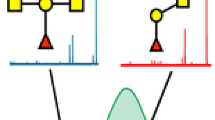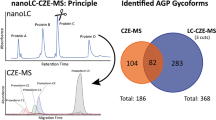Abstract
Capillary zone electrophoresis (CZE) based on electrophoretic mobility in the liquid phase and ion mobility spectrometry (IMS) based on mobilities in the gas phase are both powerful techniques for the separation of complex samples. Protein glycosylation is one of the most common post-translational modifications associated with a wide range of biological functions and human diseases. Due to their high structural variability, the analysis of glycans still represents a challenging task. In this work, the first on-line coupling of CZE with drift tube ion mobility-mass spectrometry (DTIM-MS) has been perfomed to further improve separation capabilities for the analysis of native and 8-aminopyrene-1,3,6-trisulfonic acid (APTS)-labeled N-glycans. In this way, a complexity of glycan signals was revealed which could not be resolved by these techniques individually, shown for both native and APTS-labeled glycans. Each individual glycan signal separated in CZE exhibited an unexpectedly high number of peaks observed in the IMS dimension. This observation could potentially be explained by the presence of isomeric forms, including different linkages, and/or gas-phase conformers. In addition, the type of sialic acid attached to glycans has a significant impact on the obtained drift time profile. Furthermore, the application of α2-3 neuraminidase enabled the partial assignment of peaks in the arrival time distribution considering their sialic acid linkages (α2-3/α2-6). This work is a showcase for the high potential of CZE-DTIM-MS, which is expected to find various applications in the future.

ᅟ






Similar content being viewed by others
Abbreviations
- AGP:
-
α-1-Acid glycoprotein
- APTS:
-
8-Aminopyrene-1,3,6-trisulfonic acid
- ATD:
-
Arrival time distribution
- BGE:
-
Background electrolyte
- CE:
-
Capillary electrophoresis
- CZE:
-
Capillary zone electrophoresis
- DT:
-
Drift time
- DTIM-MS:
-
Drift tube ion mobility-mass spectrometry
- ESI:
-
Electrospray ionization
- FAIMS-MS:
-
High-field asymmetric waveform ion mobility spectrometry mass spectrometry
- HILIC:
-
Hydrophilic interaction chromatography
- IMS:
-
Ion mobility spectrometry
- mAb:
-
Monoclonal antibody
- MS:
-
Mass spectrometry
- NeuNAc:
-
N-Acetylneuraminic acid
- NeuNGc:
-
N-Glycolylneuraminic acid
- SA:
-
Sialic acid
- SL:
-
Sheath liquid
- TOF-MS:
-
Time-of-flight mass spectrometry
- TWIM-MS:
-
Traveling wave ion mobility-mass spectrometry
References
Williams JP, Grabenauer M, Holland RJ, Carpenter CJ, Wormald MR, Giles K, et al. Characterization of simple isomeric oligosaccharides and the rapid separation of glycan mixtures by ion mobility mass spectrometry. Int J Mass Spectrom. 2010;298(1–3):119–27.
Rudd PM. Glycosylation and the immune system. Science. 2001;291(5512):2370–6.
Montreuil J, Vliegenthart JFG, Glycoproteins SH. New comprehensive biochemistry, vol. 29a. Amsterdam: Elsevier; 1995.
Dalziel M, Crispin M, Scanlan CN, Zitzmann N, Dwek RA. Emerging principles for the therapeutic exploitation of glycosylation. Science. 2014;343(6166):1235681.
Zhang L, Luo S, Zhang B. Glycan analysis of therapeutic glycoproteins. MAbs. 2016;8(2):205–15.
Dwek RA. Glycobiology: toward understanding the function of sugars. Chem Rev. 1996;96(2):683–720.
Wormald MR, Petrescu AJ, Pao Y-L, Glithero A, Elliott T, Dwek RA. Conformational studies of oligosaccharides and glycopeptides: complementarity of NMR, X-ray crystallography, and molecular modelling. Chem Rev. 2002;102(2):371–86.
Sanchez-De Melo I, Grassi P, Ochoa F, Bolivar J, García-Cózar FJ, Durán-Ruiz MC. N-glycosylation profile analysis of trastuzumab biosimilar candidates by normal phase liquid chromatography and MALDI-TOF MS approaches. J Proteome. 2015;127:225–33.
Ruhaak LR, Zauner G, Huhn C, Bruggink C, Deelder AM, Wuhrer M. Glycan labeling strategies and their use in identification and quantification. Anal Bioanal Chem. 2010;397(8):3457–81.
Melmer M, Stangler T, Premstaller A, Lindner W. Comparison of hydrophilic-interaction, reversed-phase and porous graphitic carbon chromatography for glycan analysis. J Chromatogr A. 2011;1218(1):118–23.
Bunz S-C, Cutillo F, Neusüß C. Analysis of native and APTS-labeled N-glycans by capillary electrophoresis/time-of-flight mass spectrometry. Anal Bioanal Chem. 2013;405(25):8277–84.
Kanu AB, Dwivedi P, Tam M, Matz L, Hill HH. Ion mobility-mass spectrometry. J Mass Spectrom. 2008;43(1):1–22.
Hofmann J, Pagel K. Glycan analysis by ion mobility-mass spectrometry. Angew Chem Int Ed. 2017;56(29):8342–9.
Aizpurua-Olaizola O, Sastre Toraño J, Falcon-Perez JM, Williams C, Reichardt N, Boons G-J. Mass spectrometry for glycan biomarker discovery. TrAC Trends Anal Chem. 2018;100:7–14.
Zheng X, Wojcik R, Zhang X, Ibrahim YM, Burnum-Johnson KE, Orton DJ, et al. Coupling front-end separations, ion mobility spectrometry, and mass spectrometry for enhanced multidimensional biological and environmental analyses. Ann Rev Anal Chem. 2017;10(1):71–92.
Li J, Purves RW, Richards JC. Coupling capillary electrophoresis and high-field asymmetric waveform ion mobility spectrometry mass spectrometry for the analysis of complex lipopolysaccharides. Anal Chem. 2004;76(16):4676–83.
Mironov GG, Okhonin V, Khan N, Clouthier CM, Berezovski MV. Conformational dynamics of DNA G-quadruplex in solution studied by kinetic capillary electrophoresis coupled on-line with mass spectrometry. Chem Open. 2014;3(2):58–64.
Mironov GG, Clouthier CM, Akbar A, Keillor JW, Berezovski MV. Simultaneous analysis of enzyme structure and activity by kinetic capillary electrophoresis–MS. Nat Chem Biol. 2016;12(11):918–22.
Hallen RW, Shumate CB, Siems WF, Tsuda T, Hill HH. Preliminary investigation of ion mobility spectrometry after capillary electrophoretic introduction. J Chromatogr. 1989;480:233–45.
Nakano M. Detailed structural features of glycan chains derived from 1-acid glycoproteins of several different animals: the presence of hypersialylated, O-acetylated sialic acids but not disialyl residues. Glycobiology. 2004;14(5):431–41.
Yamaguchi Y, Nishima W, Re S, Sugita Y. Confident identification of isomeric N-glycan structures by combined ion mobility mass spectrometry and hydrophilic interaction liquid chromatography. Rapid Commun Mass Spectrom. 2012;26(24):2877–84.
Struwe WB, Baldauf C, Hofmann J, Rudd PM, Pagel K. Ion mobility separation of deprotonated oligosaccharide isomers – evidence for gas-phase charge migration. Chem Commun. 2016;52(83):12353–6.
Stow SM, Causon TJ, Zheng X, Kurulugama RT, Mairinger T, May JC, et al. An interlaboratory evaluation of drift tube ion mobility-mass spectrometry collision cross section measurements. Anal Chem. 2017;89(17):9048–55.
Cumming DA, Hellerqvist CG, Harris-Brandts M, Michnick SW, Carver JP, Bendiak B. Structures of asparagine-linked oligosaccharides of the glycoprotein fetuin having sialic acid linked to N-acetylglucosamine. Biochemistry. 1989;28:6500–12.
Author information
Authors and Affiliations
Corresponding author
Ethics declarations
Conflict of interest
The authors declare that they have no conflict of interest.
Additional information
Published in the topical collection Close-Up of Current Developments in Ion Mobility Spectrometry with guest editor Gérard Hopfgartner.
Publisher’s Note
Springer Nature remains neutral with regard to jurisdictional claims in published maps and institutional affiliations.
Electronic supplementary material
ESM 1
(PDF 696 kb)
Rights and permissions
About this article
Cite this article
Jooß, K., Meckelmann, S.W., Klein, J. et al. Capillary zone electrophoresis coupled to drift tube ion mobility-mass spectrometry for the analysis of native and APTS-labeled N-glycans. Anal Bioanal Chem 411, 6255–6264 (2019). https://doi.org/10.1007/s00216-018-1515-7
Received:
Revised:
Accepted:
Published:
Issue Date:
DOI: https://doi.org/10.1007/s00216-018-1515-7




